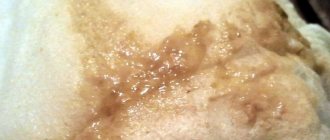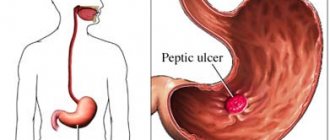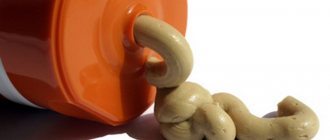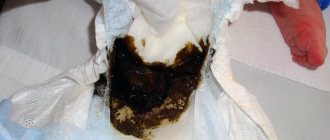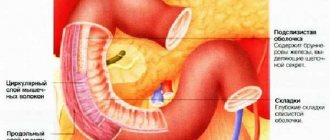2) consumption of foods that help normalize stool. • drinking plenty of water (more than 1.5 - 2 liters per day) • drinking prune decoction has a very good effect (pour 5 - 10 dried prunes into one glass of boiling water overnight, drink this decoction on an empty stomach in the morning); • ingestion of vegetable oils 30 minutes before meals, 1 teaspoon 2-3 times a day, has a good effect (use sunflower, olive, vaseline oil, the drug “Tykveol” based on pumpkin seed oil).
And also, after visiting the toilet, you should not use toilet paper, but wet, alcohol-free baby wipes and wash yourself.
All this while you go to the doctor, and after examination and making the correct diagnosis, the proctologist will prescribe treatment for the identified problem.
PS If you need more detailed communication in person in an online chat, then write
Only during a personal consultation meeting can a doctor make the correct diagnosis and choose the most appropriate treatment. Answers to questions on-line cannot replace consultation with a specialist.
Causes of the pathological condition
In fact, the presence of blood during bowel movements is a loud signal of a certain disease. To find out the exact origin of the pathological condition, you need to consult your doctor.
Reasons that lead to blood in the stool:
- rectal fissures, proctitis, hemorrhoids near the anus;
- polyps, benign or malignant tumors of the rectum;
- Crohn's disease (inflammatory process of the gastrointestinal tract), ulcerative colitis in the acute stage;
- intestinal infection (dysentery, amoebiasis, gastroenteritis, etc.);
- intestinal thrombosis, including pathology of blood vessels and mesentery;
- helminthiasis;
- cirrhosis of the liver, open ulcer of the stomach or duodenum;
- sometimes – dysbacteriosis.
There is a pattern: the brighter the blood in the stool, the closer the source of the disease is located. Bacteria tend to give the stool a dark tint, so in case of gastrointestinal pathology, microorganisms have time to “make their contribution” during the passage of digested food, so at the exit the patient notes a rich cherry color. But with an intestinal disease, the blood will always be bright scarlet, because the source is located very close and the color shade simply does not have time to change.
Blood in the stool during pregnancy: why does it happen?
Very often, expectant mothers, while waiting for a miracle, are faced with the problem of bleeding during bowel movements. And although it is difficult to detect this in the stool itself, bright red marks are clearly visible on toilet paper after the cleansing procedure. Most often, this symptom is observed with constipation.
Causes of constipation during pregnancy:
- Due to weight gain, a woman may experience low physical activity. Stagnation of blood in the pelvis leads to inadequate passage of feces through the large intestine.
- Lack of fluid intake. If edema is present, gynecologists often recommend reducing the amount of water you drink; this can subsequently lead to dry stool and subsequent injury to the intestinal wall.
- Increased levels of progesterone in the blood. This hormone affects intestinal motility, disrupting its proper functioning.
All of the above conditions lead to anal fissures, which, when damaged, bleed and hurt.
The presence of blood after bowel movement is an unfavorable symptom during pregnancy. Impaired hemostasis can have a negative impact on the baby.
Treatment
Therapy will vary and depend on the diagnosis, so there can be no specific advice on its implementation.
Cause and possible treatment
- Intestinal obstruction, ulcers, neoplasms. Urgent hospitalization in a surgical or oncology department.
- Ulcerative colitis (mild to moderate). Prescribing medications and special diets for constipation.
- Hemorrhoids or anal injuries. Depends on the severity, can be performed on an outpatient basis and through surgery.
Preventive measures
Using laxatives or enemas for constipation. It is important to understand that this measure cannot be permanent, as there is a risk of addiction and further failure of independent defecation.- Doing physical exercise every day .
- Timely treatment of gastrointestinal pathologies .
- Following a diet , it includes foods that have a mild laxative effect. It is necessary to ensure that the body receives the required amount of fiber; it has a beneficial effect on intestinal motility and reduces the risk of developing dysbiosis.
The regular diet should contain products predominantly of plant and dairy origin. will help prevent constipation with blood, as well as completely cope with it :
- beet;
- figs;
- kefir;
- prunes, dried apricots;
- bran;
- yoghurts, ayran;
- pumpkin;
- oatmeal and barley porridge;
- flax seed;
- fresh vegetables and fruits.
Important! Cabbage or cucumber pickle can be a good help for constipation. You need to drink it 4 times a day, 0.5 cups at a time.
During your recovery
, avoid highly spicy and smoked foods, reduce your consumption of flour products, processed foods, potatoes and rice.
In the absence of serious pathologies, proper nutrition and an active lifestyle .
How to treat?
Without consulting a doctor and taking tests, talking about a specific treatment is pointless. First of all, it is necessary to find out what disease is causing the blood to appear after bowel movements. So, for banal constipation, a special diet and exercise are prescribed. If hemorrhoids are the culprit, then suppositories and sometimes surgery are recommended. Many people probably know how to treat an infection, because the scheme is simple: antibiotics and rehydration therapy. For oncology, surgery is recommended in parallel with chemotherapy and radiation exposure.
If the patient experiences severe bleeding, then an ambulance should be called immediately, and until they arrive, ensure rest and place an ice pack in the perineal area.
Often, a person who is in the constant turmoil of his work and personal life does not notice his periodic abdominal pain.
The result of such an inattentive attitude towards oneself subsequently turns out to be an unpleasant symptom in the form of blood on toilet paper every time after defecation.
Only half of those who discover such a problem turn to a proctologist for examination.
The second half is simply waiting for the problem to be resolved on its own, which triggers the process of destruction of the body, since blood from the intestines can signal the presence of serious problems, including even rectal cancer.
Complications of thrombosis
Another reason for the release of blood clots from the anus is thrombosis of the hemorrhoid. This dangerous complication occurs when the plexus falls out of the anus and becomes pinched by the sphincter. The injury provokes the appearance of blood, acute pain and swelling in the perineal area. It develops rapidly and is accompanied by high fever. Symptoms characteristic of the problem:
- a dark blue round lump forms near the anus;
- it is difficult for the patient to sit on a hard surface, walking is painful;
- there is a sensation of a foreign body in the perineal area;
- the pain is pulsating.
In such a situation, the proctologist urgently needs to remove the clot from the blocked vessel in order to eliminate blood stagnation. The operation consists of cutting the prolapsed node and clearing away the accumulated blood clots. At the same time, the specialist can remove other hemorrhoidal cones to prevent the recurrence of a dangerous complication. Further treatment consists of rehabilitation with the help of venotonics and anti-inflammatory drugs. The wound should be treated with ointments:
- Levomekol;
- Heparin;
- Methyluracil;
- Troxevasin.
When bleeding and clots appear, a person needs to monitor and measure hemoglobin levels more often. Its sharp drop leads to oxygen starvation, a constant feeling of weakness and fatigue, headaches and insomnia. Prevention consists of following a proper diet, rich in proteins and vitamins, and leading an active lifestyle.
Are traces of blood on paper a reason to panic?
Traces of blood on toilet paper are not always accompanied by pain. It happens that a person feels good, even excellent, but bloody discharge from the intestines haunts him.
Of course, the appearance of blood in the stool is preceded by some reason, for example, prolonged constipation or diarrhea.
The presented factors lead to the formation of injury to the intestinal mucosa or the formation of an anal fissure.
Blood often appears in pregnant women - this symptom is fundamental for seeing a doctor, since scarlet discharge can indicate serious pressure from the uterus on the intestines.
Prevention of difficult stools and bleeding
To avoid problems with emptying, you need to take preventive measures in advance. To do this, you need to prevent diseases that become the causes of this symptom. In general, it is recommended:
- Adjust your diet throughout the day to ensure free movement of stool in the intestines.
- Maintain body tone, creating conditions for the normal functioning of all internal systems of the body.
- Get checked regularly at the clinic and prevent the onset of the disease in a timely manner.
- If an illness occurs, get rid of it using an enema or laxative.
Maintaining health is the main task in a person’s life. The practice of healthy eating, constant activity and disease prevention gives a person health for many years. During the first symptoms of the disease, you should not resort to self-medication. Immediate consultation with a medical specialist will relieve the unpleasant symptoms of the disease and leave you with peace of mind. Even constipation in its advanced form has serious health consequences and is treated slowly.
When blood appears due to constipation, any person begins to look for the causes of the ailment. When determining the factors that could lead to this phenomenon, it is worth considering the shade of the bleeding. This will allow us to understand the localization of the inflammatory process and disturbances in the functioning of the organ. Scarlet color may indicate a pathology of the large intestine, brown may indicate a malfunction of the small intestine, and black feces indicate bleeding in the upper gastrointestinal tract (gastrointestinal tract).
Causes of bleeding
Before contacting a proctologist for examination, you should take a close look at the color of the blood and track the time or reasons for its appearance.
Such actions are necessary to refine the diagnosis - the specialist will definitely ask the above questions.
The reasons for the appearance of blood from the intestines can be divided into two main criteria, when pain is felt in the abdomen or anus. This is the main focus for further examination.
So, after identifying traces of blood on toilet paper, you need to take a closer look at its color and consistency.
These factors may indicate the presence of a certain disease, which includes:
- If the blood is scarlet and mixed with feces , this is a direct confirmation of the development of hemorrhoids or the formation of an anal fissure.
- Scarlet blood can remain on toilet paper even if it is simply “soaked” without defecation - such signs may indicate that the patient has internal hemorrhoids, fissures, and even rectal cancer.
- Traces of scarlet blood and mucus on underwear also indicate the development of hemorrhoids in the later stages, where rectal prolapse can also be diagnosed.
- Traces of scarlet blood on underwear without additional discharge and without previous aspects for their formation (for example, heavy lifting) indicate the development of colorectal cancer.
- If blood on underwear appears with mucus and mixed with feces , most likely the person develops ulcerative colitis, proctitis, and polyps and tumors of the rectum may occur.
- , massive bleeding can occur .
- Often a patient complains to a specialist about the presence of black stool , which appears with some regularity or constantly - such signs indicate bleeding of dilated veins of the esophagus, the development of cirrhosis of the liver, ulcers and even stomach cancer.
Associated symptoms
As mentioned above, bleeding is accompanied by pain in the abdomen or anus.
But often there are symptoms of a slightly different nature, when bleeding may indicate the development of a certain disease:
- massive bleeding may be accompanied by low blood pressure, pale skin and dizziness , such signs may already indicate significant blood loss;
- with hemorrhoids or anal fissure, the patient experiences sphincter spasms ;
- prolonged diarrhea may indicate the development of an infectious disease, balantidiasis;
- cramping abdominal pain often becomes symptoms of ulcers, ulcerative colitis, tumor formation in the intestines, as well as dysentery;
- the presence of elevated body temperature indicates that the patient is progressing to a certain infectious disease.
If there are accompanying symptoms, the patient should definitely contact a proctologist for diagnosis, since infectious diseases can be dangerous for others.
What to do if you are bleeding
As already described above, if there is bleeding from the intestines, you should visit a proctologist to diagnose the disease. When visiting a specialist, it is necessary to talk fully and in detail about your problem and mention the accompanying symptoms.
As a rule, a specialist will prescribe the patient to undergo a series of examinations; among the most popular and informative diagnostic methods are:
- Rectoscopy - allows you to detect pathologies of the lower intestinal tract, is prescribed for pain in the anus.
- Colonoscopy - prescribed for abdominal pain, the examination makes it possible to identify almost all changes in the intestines.
- Irrigoscopy - used to diagnose tumors and other lesions by introducing a special substance and an x-ray.
- Gastroduodenoscopy - used to examine the stomach and intestines, and take mucous membranes for a biopsy to identify the presence of cancer cells.
- Laparoscopy or abdominal surgery is an incision in the abdominal cavity to collect fluid, mucous membrane and other components for examination. This diagnostic method also allows for additional treatment of the existing disease. Used only after detecting suspicious areas.
Blood on toilet paper is a dangerous sign of the development of a disease that can cause a lot of trouble for the patient or lead to complications. You should not delay diagnosis, as such delays can be fatal.

